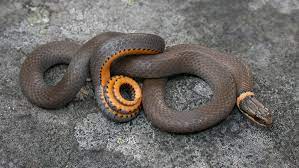Reptiles come in many forms, each with its own distinctive features that spark curiosity. As we explore these creatures, their unique body structures often raise questions about how they function in the world. One such question that stands out is, Do snakes have tails?
Their long, sinuous bodies seem to flow seamlessly from one end to the other, making it hard to distinguish where the head ends and the body begins. This leads to intriguing discussions about their anatomy and evolutionary adaptations.
Do snakes have tails?

Snakes do have tails, though they might not look the way we expect. Unlike animals with obvious, external tails like mammals or lizards, a snake’s tail is a continuation of its body but with specific anatomical features that help it function in unique ways.
A snake’s body is generally divided into two main parts: the head and the rest of its body, which includes the tail. The tail starts where the snake’s digestive system ends, just after the vent, which is the opening through which waste is expelled. This tail is made up of vertebrae like the rest of its body, and its length can vary depending on the species.
The tail often serves important purposes. For example, in some species, it helps with balance, movement, and stability, especially when the snake is slithering or climbing. In others, the tail may be used as a defensive mechanism, like when it mimics the head in some species, or it can even act as a lure to attract prey in species like the Eastern Coral Snake.
The tail of a snake is also crucial for locomotion. Some species, like boas and pythons, use their tails to anchor themselves while they constrict prey or maneuver around objects. While it may not look like a traditional tail, it’s an essential part of a snake’s anatomy that plays an important role in its survival.
Anatomy of a Snake’s Tail
The anatomy of a snake’s tail may seem simple at first glance, but it is actually a highly specialized structure designed for survival. From its unique vertebrae to its function in the snake’s daily life, the tail plays several important roles. Here’s a detailed look at the anatomy of a snake’s tail:
- Vertebrae
The snake’s tail, like its body, is made up of vertebrae that are specialized for flexibility. The tail begins just after the vent (the opening for waste elimination) and consists of many small, closely packed vertebrae. These vertebrae allow the tail to be highly flexible and assist in locomotion. - Muscles
The muscles in the tail are essential for movement. They work together with the vertebrae to allow the snake to slither, coil, or climb effectively. These muscles also contribute to the movement of the snake when striking prey or using the tail for balance. - Scales
The tail, like the rest of the snake’s body, is covered in scales. The scales on the tail are typically smaller and more specialized for movement compared to the scales on the rest of the body. In some species, the tail might have keeled scales, which aid in grip and traction, especially for climbing. - Ventral Surface
The underside of the tail, known as the ventral surface, has specialized scales known as “subcaudal scales.” These scales help the snake with locomotion by gripping surfaces as it moves, aiding in the movement over different terrains. - Tail Tip
The tip of the tail, which varies in length, is typically less muscular and may serve a variety of functions depending on the species. For example, in some species, the tail may have a rattle or a colorful tip to act as a defense mechanism to ward off predators. - Function in Locomotion
The tail plays a crucial role in how a snake moves. It is involved in forms of locomotion like lateral undulation, rectilinear movement, and sidewinding. The tail helps the snake push against surfaces to propel its body forward or stabilize itself while climbing or hunting. - Tail as Defense
In some snake species, the tail is used for defensive purposes. For example, rattlesnakes use their rattling tail to warn predators. Other snakes may hide their head and use the tail as a decoy to confuse threats. - Reproductive Function
In some species, the tail plays a role in reproduction. Male snakes often use their tail to insert one of their hemipenes (reproductive organs) into the female during mating. The length and flexibility of the tail assist in this process.
While the tail of a snake might seem like a simple extension of its body, it is an integral part of its anatomy. From aiding in locomotion to serving as a tool for defense or reproduction, the tail is a vital component that contributes to the snake’s ability to thrive in its environment. Its specialized structure and functions make it a fascinating aspect of snake biology.
How Snakes Use Their Tails

The tail of a snake is not just a simple extension of its body—it’s a highly specialized tool that plays a significant role in the snake’s behavior and survival. The use of a snake’s tail varies among species and can serve a range of functions from movement to defense. Below is how snakes use their tails:
- Locomotion
Snakes primarily use their tails to aid in locomotion. The tail helps them in several types of movement, including lateral undulation (the most common form), sidewinding, and rectilinear motion. The tail provides balance and propulsion, allowing the snake to slither, climb, or even swim with agility. - Balance and Stabilization
While moving, especially when climbing or navigating through uneven terrain, the tail helps maintain the snake’s balance. It acts as a stabilizer, counterbalancing the rest of the body and helping the snake stay aligned, especially in difficult or vertical environments like trees or rocks. - Defense Mechanism
Many snake species use their tails as a defense mechanism. For example, rattlesnakes use the distinctive rattling sound made by their tail to ward off potential threats, signaling that they are dangerous. Other species, like the Eastern Coral Snake, may hide their heads and display a brightly colored tail to confuse predators and make them think the tail is the head. - Prey Attraction and Hunting
Certain species of snakes use their tails as a lure to attract prey. The Eastern Coral Snake, for example, may have a brightly colored tail that mimics the appearance of a worm or insect, tricking smaller animals into coming closer, allowing the snake to strike more effectively. - Communication
The tail is often used in signaling or communication with other snakes. In some species, a snake will flick or wave its tail as part of courtship displays, or to warn other snakes of danger. This tail movement is part of the broader repertoire of behavioral communication that helps snakes interact with their environment. - Constricting Prey
Some snake species, particularly boas and pythons, use their tail to help immobilize and constrict prey. When wrapping around a target, the tail provides an anchor to secure the snake’s grip, while the rest of the body coils tighter to capture and suffocate the prey. - Reproductive Functions
During mating, male snakes use their tail to position one of their hemipenes (reproductive organs) inside the female’s cloaca. The length and flexibility of the tail assist in this delicate process, especially when the snakes are engaged in complex mating behaviors. - Regeneration and Tail Loss
Some species of snakes, like certain types of geckos, may be able to shed or lose part of their tail as a defense mechanism when grabbed by a predator. This tail loss (called autotomy) can confuse predators, giving the snake a chance to escape. Although not all snakes can regenerate their tails, some may heal the wound where the tail was lost.
The tail of a snake serves numerous essential purposes that are critical to its survival. From aiding in movement and maintaining balance to acting as a tool for communication, defense, and hunting, the tail is an incredibly versatile part of a snake’s anatomy. Its varied uses make it a vital asset, helping snakes adapt to and thrive in their diverse environments.
What Happens If a Snake Loses Its Tail?
If a snake loses its tail, the outcome largely depends on the species and the circumstances of the tail loss. Unlike some animals that can easily regenerate limbs or tails, most snakes do not have the ability to regrow their tails. However, the loss of a tail can still have significant effects on the snake’s health and behavior. Here’s a closer look at what happens when a snake loses its tail:
- Tail Loss (Autotomy)
Some species of snakes, particularly those that are part of the reptile family with a higher tendency for self-defense mechanisms, may shed their tail as a defense response. This process is known as autotomy. When a snake is threatened or grabbed by its tail, it can deliberately sever the tail at a weak point in the vertebrae to escape from a predator’s grip. The severed tail may wriggle and distract the predator, giving the snake a chance to flee.
- Impact on Movement
Losing its tail can severely impact a snake’s ability to move efficiently. The tail is an important part of the snake’s locomotion, contributing to stability and balance during slithering, climbing, or swimming. Without its tail, the snake may have a harder time navigating certain terrains, and it may move less fluidly. This could make the snake more vulnerable to predators or less effective in capturing prey.
- Loss of Defensive Functionality
The tail also serves as a defensive tool in many species. For example, rattlesnakes use their tail to produce a rattling sound that signals danger to potential predators. If a snake loses its tail, it loses this important defense mechanism, which can increase its vulnerability to threats.
- Difficulty in Reproduction
In species where the tail plays a role in reproduction (such as in mating, where the male uses his tail to insert one of his hemipenes into the female), losing part or all of the tail can affect mating success. Without the full functionality of its tail, a snake may find it more difficult to mate or reproduce effectively.
- Healing and Recovery
After losing a tail, the snake will typically experience some level of trauma and stress. The area where the tail was severed will heal over time, but the snake will never regenerate its lost tail. The healing process is usually focused on repairing the wound, which may form a scar or protective skin, but the snake’s overall functionality will be altered. If the snake lost the tail due to injury or trauma, it may experience ongoing health problems, especially if the tail loss was not clean or if infection sets in.
- Survival and Adaptation
While a snake can survive without its tail, it may face challenges. For some snakes, especially those that are already in a vulnerable position, losing the tail can reduce their chances of survival. For others, especially those that rely on their tail for balance, losing it might necessitate adapting new methods of movement and self-defense. The snake may become more cautious, avoiding danger where possible and relying on other strategies for hunting and evading predators.
Losing its tail is a traumatic event for a snake, and while it may survive, the consequences can significantly impact its behavior, movement, and overall well-being. The tail is crucial to a snake’s anatomy, so the loss of it is not without serious ramifications. However, snakes are adaptable creatures, and even without a tail, they can continue to live—though their survival might be more challenging in the wild.
Fun Facts About Snake Tails

Snake tails are fascinating and unique features of these reptiles, with a variety of functions and surprising facts. Here are some fun and interesting facts about snake tails:
- Rattle for Defense
The most famous snake tail feature belongs to the rattlesnake. Its tail ends in a segmented “rattle” that it shakes when threatened. This warning sound is a form of communication that helps keep predators away by signaling the snake’s readiness to defend itself.
- Mimicking Heads
Some species of snakes, like the Eastern Coral Snake, have brightly colored tails that are used to confuse predators. These colorful tails can mimic the head of the snake, making it difficult for potential threats to figure out which end of the snake is actually the head. This trick helps the snake evade predators.
- Luring Prey
In certain snake species, the tail acts as a lure. For example, the Texas Patch-Nosed Snake uses its tail to wiggle and attract small prey like lizards or amphibians, making the tail an effective tool for hunting. Some other species use their tails to imitate worms or insects to trick prey into approaching.
- Tail Loss for Survival
Many snakes can lose part of their tail as a defense mechanism, a process known as autotomy. The tail wriggles after being detached, distracting predators and giving the snake a chance to escape. While most snakes don’t regenerate their tails, some species of lizards can grow back lost tails—though not snakes!
- Tail Used in Mating
Snake tails are also crucial in reproduction. Male snakes use their tails to insert their hemipenes (paired reproductive organs) into the female’s cloaca during mating. This process relies heavily on the tail’s dexterity and length, with some species having longer or more flexible tails to aid in reproduction.
- Vibrations for Communication
Some snakes use their tails to communicate with other snakes. In species like the Garter Snake, the tail is often used to vibrate against the ground or bushes as a form of signaling to others, whether it’s to warn of danger or to attract a mate.
- Tail as a Balance Tool
A snake’s tail acts as a counterbalance when climbing or slithering through difficult terrain. It helps stabilize the snake’s body, ensuring that it can move smoothly even in challenging environments like trees, rocks, or sand.
- Some Snakes Have Colorful Tails
Many snake species have brightly colored or patterned tails, which might not always serve as a defense mechanism. In some cases, the colors may simply play a role in camouflage or be used to attract mates. For example, the Western Hognose Snake has a distinctive, colorful tail tip that it may use to ward off predators.
- Incredible Flexibility
A snake’s tail is incredibly flexible, which is essential for its mobility. Some species, like the Sidewinder rattlesnake, use their tails to help with sidewinding—a unique form of movement that allows them to glide across sandy deserts with minimal friction.
- The Tail Helps in Constriction
For snakes like pythons and boas, the tail plays a critical role in constricting prey. The tail helps anchor the snake’s grip, allowing it to wrap around and immobilize its prey by squeezing it tightly.
Snake tails are not just simple appendages but highly specialized tools that serve a variety of fascinating purposes—from communication and defense to hunting and reproduction. These tails are key to many aspects of a snake’s life and survival, and their unique adaptations make them even more intriguing!
Conclusion
Snakes, like all reptiles, have tails, which are an essential part of their anatomy. These tails are the final portion of their bodies, extending from the cloaca to the end of their spine. Do snakes have tails? Yes, they do, and these tails vary in length and function depending on the species. For some, the tail is used for balance, communication, or even defense. So, while their tails may not always be as prominent as in other animals, they definitely play a role in the snake’s survival and movement.

